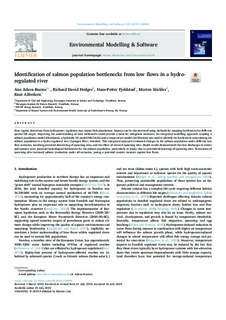| dc.contributor.author | Adeva Bustos, Ana | |
| dc.contributor.author | Hedger, Richard David | |
| dc.contributor.author | Fjeldstad, Hans-Petter | |
| dc.contributor.author | Stickler, Morten | |
| dc.contributor.author | Alfredsen, Knut | |
| dc.date.accessioned | 2019-08-12T09:27:39Z | |
| dc.date.available | 2019-08-12T09:27:39Z | |
| dc.date.created | 2019-08-04T09:30:15Z | |
| dc.date.issued | 2019 | |
| dc.identifier.citation | Environmental Modelling & Software. 2019, 120 . | nb_NO |
| dc.identifier.issn | 1364-8152 | |
| dc.identifier.uri | http://hdl.handle.net/11250/2607869 | |
| dc.description.abstract | Flow regime alterations from hydropower regulation may impact fish populations. Impacts can be characterized using methods for mapping bottlenecks for different species life stages. Improving the understanding of such bottlenecks could provide a basis for mitigation measures. An integrated modelling approach coupling a salmon population model (IB-salmon), a hydraulic 1D model (HEC-RAS) and a temperature model (Air2Stream) was used to identify the bottlenecks constraining the salmon population in a hydro-regulated river (Ljungan River, Sweden). This integrated approach evaluated changes in the salmon population under different low flow scenarios, involving potential dewatering of spawning sites, and the effect of restored spawning sites. Model results demonstrated that low discharges in winter and summer were potential hydrological bottlenecks for the salmon population, particularly in winter due to potential dewatering of spawning sites. Restoration of spawning sites increased salmon production under all scenarios, posing a potential counter measure against low flows. | nb_NO |
| dc.language.iso | eng | nb_NO |
| dc.publisher | Elsevier | nb_NO |
| dc.rights | Attribution-NonCommercial-NoDerivatives 4.0 Internasjonal | * |
| dc.rights.uri | http://creativecommons.org/licenses/by-nc-nd/4.0/deed.no | * |
| dc.title | Identification of salmon population bottlenecks from low flows in a hydro-regulated river | nb_NO |
| dc.type | Journal article | nb_NO |
| dc.type | Peer reviewed | nb_NO |
| dc.description.version | publishedVersion | nb_NO |
| dc.source.pagenumber | 11 | nb_NO |
| dc.source.volume | 120 | nb_NO |
| dc.source.journal | Environmental Modelling & Software | nb_NO |
| dc.identifier.doi | 10.1016/j.envsoft.2019.104494 | |
| dc.identifier.cristin | 1713901 | |
| dc.relation.project | Norges forskningsråd: 193818 | nb_NO |
| dc.description.localcode | © 2019 The Authors. Published by Elsevier Ltd. This is an open access article under the CC BY-NC-ND license (http://creativecommons.org/licenses/by-nc-nd/4.0/) | nb_NO |
| cristin.unitcode | 194,64,91,0 | |
| cristin.unitname | Institutt for bygg- og miljøteknikk | |
| cristin.ispublished | true | |
| cristin.fulltext | original | |
| cristin.qualitycode | 2 | |

